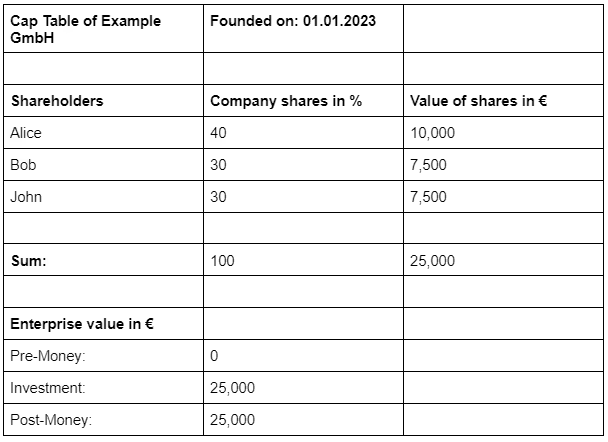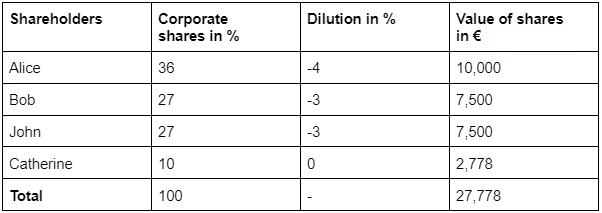What is a Cap Table?
As a founder of a startup, sooner or later, you'll likely need to raise external capital to fuel growth. When delving into the world of financing rounds, you quickly come across the term "Cap Table”. Like many terms in the startup scene, this one also originates from the US. This blog article will explain what lies behind the term and what you should consider when creating a Cap Table.
What is the structure of a Cap Table?
An exemplary Cap Table
A Cap Table is a comprehensive listing of all shareholders invested in your company. It provides you with a transparent overview of ownership proportions within your startup, outlining shares, capital contributions, company value, and voting rights. While there are no fixed rules, the essential aspect is clarity and logical coherence. A Cap Table may take on a straightforward structure like the following:

How is the Cap Table structured?
The upper segment of the Cap Table typically includes general details, such as the company's name and incorporation date.
Below that, you'll find a list of all shareholders, along with their ownership percentages and the value of their shares in euros.
The lower portion of the Cap Table showcases the company's value in euros, housing additional terminology from the startup scene: pre-money valuation, investment, and post-money valuation.
Pre-Money Valuation
“Pre-Money” refers to the value of your startup before any investments have been made.
Investment
The term “investment" represents the amount of funds invested in your startup and is usually self-explanatory.
Post-Money Valuation
The “Post-Money Valuation” reflects your company’s value after the investment has been made.
These values change as soon as a financing round is completed. Providing these values offers readers of your cap table a concise overview of your company's valuation.
Why do I need a Cap Table?
In general, creating a Cap Table isn't obligatory. If you and your business partners plan to exclude investors from your startup, it becomes unnecessary as ownership structure remains unchanged.
The significance of a Cap Table arises when you onboard new shareholders into your startup. This happens when you require external financial support from venture capitalists, business angels, friends, or family. In return for their investment, they seek shares in the company. Creating a Cap Table assists in maintaining oversight and estimating power dynamics.
As a founder, it's crucial to monitor your shares, as they hold value during an exit and safeguard your influence within the company. A Cap Table is not only vital for you but also for potential investors. They, too, wish to assess their influence and understand the individuals involved in future decision-making processes. Thus, crafting a Cap Table offers transparency into your company's structure for potential investors.
How do I create a Cap Table?
Creating a Cap Table can become complicated as soon as multiple investors need to be considered. Spreadsheet programs such as "Excel" can be used to create your Cap Table.
Alternatively, there are paid tools that specialize in the automatically generating Cap Tables. Examples include Eqvista and captable.io.
What does a Cap Table look like in Tokenize.it?
Enter our product, Tokenize.it, a revolutionary solution that elevates cap table management to new heights. With every investment made through Tokenize.it, all information is aggregated in our user-friendly dashboard. This keeps you, as a founder, informed and saves valuable time.
It is important to note that only the tokens acquired by your investors and their investment are represented. These tokens solely represent participation rights in your company and do not denote actual company shares. If you're curious about how Tokenize.it works, feel free to explore our FAQ.
How many shares should I give away?
Another question on the minds of many founders in the context of the Cap Table is: "How many shares should I give away from my company?"
Of course, this is primarily a matter of negotiation, with conflicting interests at play. As a founder, you aim to sell as few shares as possible for a high price. On the other hand, investors strive to receive as many shares as possible for a low price.
During the financing round, you agree on the value of your startup and negotiate the investment amount as well as the company shares to be transferred. During negotiation, several factors should be considered to maintain an appealing Cap Table.
Avoid too many parties
Having too many voices in the Cap Table are disadvantageous for both parties because they make it difficult to reach a consensus and can unnecessarily drag out critical decisions. Therefore, you should focus on quality instead of quantity when filling your Cap Table.
Tokenize.it offers the advantage of accommodating multiple investors in your digital Cap Table without impairing consensus. This is because investors exclusively acquire digital tokens that reflect privileges in your company but do not grant genuine voting rights.
Protect your negotiating position
Never enter a negotiation if you are financially cornered. A tense financial situation gives investors a stronger position and they could demand more shares from you.
Be aware of your financial situation
To avoid being cornered financially, you should maintain awareness of your financial situation. Approach the negotiation with a clear, realistic understanding of your shares' value and the required investment. Be conscious of your limits and don't hesitate to reject a deal that doesn't align with your company goals.
Keep an eye on your voting power
Cultivate a good relationship with your business partners. This will enable you to join forces to form a majority, allowing decisions to be enforced even if some investors oppose.
Pay attention to the dilution of your shares
Another important consideration in negotiations involving the admission of new investors is share dilution. As new funds enter your company, the base capital increases, causing a decrease in your share percentage. Power dynamics might shift, potentially reducing your decision-making authority in the company.
Share dilution - calculation example
To illustrate what happens when company shares are diluted, we have prepared a calculation example.
Let’s consider a startup with the following cap table:

You have already encountered this Cap Table as an example from the beginning of the article. In this scenario, three founders are involved: Alice, Bob, and John. Their shares are evenly distributed, with Alice holding a slightly larger portion. The total company value is 25,000€.
Alice, Bob, and John wish to expand and decide to include Business Angel Catherine in their Cap Table. They now wonder what the dilution of their shares will be if Catherine acquires 10% of the company.
How is the Cap Table changing?
Firstly, Catherine is added to the list of shareholders. In order to clarify which values are being sought in the Cap Table, they have been marked with question marks.

Now, let’s move on to the calculation of the dilution of the shares:
The current value of the company (25,000€) represents 90% of the future value, since Catherine is to receive 10% of the value. Mathematically, we're aiming to determine the future 100% company value.
To calculate this, divide the current value of the company by the future percentage share:
25,000€ / 0.9 = 27,778€
This means that the base capital needs to increase by 2,778€ for Catherine to receive her 10% stake in the company.
Based on this result, we can proceed to calculate the dilution and the new shares of the founders:
Alice: 10,000€ / 27,778€ = 36%.
Bob: 7,500€ / 27,778€ = 27%
John: 7,500€ / 27,778€ = 27%
Catherine: 2,778€ / 27,778€ = 10%
The new Cap Table, reflecting the diluted shares looks like this:

The updated Cap Table illustrates that the founders' shares were diluted due to the increase in capital. It's important to note that the original value of the shares remains unchanged; only the percentage of ownership is affected. In this scenario, dilution is relatively minor. However, this effect could become more pronounced during subsequent financing rounds.
Conclusion
In summary, the Cap Table is a critical tool for founders looking to involve investors in their company. It offers a clear representation of capital structure and ownership proportions. This allows founders to provide potential investors with transparency and create a well-informed basis for decisions. A well-structured Cap Table eases future financing rounds and negotiations by providing a clear and concise overview of how new investments impact existing shareholders.














